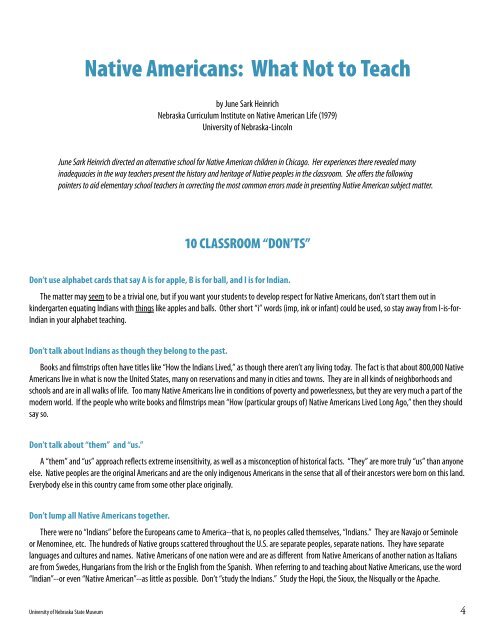Teacher's Guide - University of Nebraska State Museum - The ...
Teacher's Guide - University of Nebraska State Museum - The ...
Teacher's Guide - University of Nebraska State Museum - The ...
You also want an ePaper? Increase the reach of your titles
YUMPU automatically turns print PDFs into web optimized ePapers that Google loves.
<strong>University</strong> <strong>of</strong> <strong>Nebraska</strong> <strong>State</strong> <strong>Museum</strong><br />
Native Americans: What Not to Teach<br />
by June Sark Heinrich<br />
<strong>Nebraska</strong> Curriculum Institute on Native American Life (1979)<br />
<strong>University</strong> <strong>of</strong> <strong>Nebraska</strong>-Lincoln<br />
June Sark Heinrich directed an alternative school for Native American children in Chicago. Her experiences there revealed many<br />
inadequacies in the way teachers present the history and heritage <strong>of</strong> Native peoples in the classroom. She <strong>of</strong>fers the following<br />
pointers to aid elementary school teachers in correcting the most common errors made in presenting Native American subject matter.<br />
10 CLASSROOM “DON’TS”<br />
Don’t use alphabet cards that say A is for apple, B is for ball, and I is for Indian.<br />
<strong>The</strong> matter may seem to be a trivial one, but if you want your students to develop respect for Native Americans, don’t start them out in<br />
kindergarten equating Indians with things like apples and balls. Other short “i” words (imp, ink or infant) could be used, so stay away from I-is-for-<br />
Indian in your alphabet teaching.<br />
Don’t talk about Indians as though they belong to the past.<br />
Books and filmstrips <strong>of</strong>ten have titles like “How the Indians Lived,” as though there aren’t any living today. <strong>The</strong> fact is that about 800,000 Native<br />
Americans live in what is now the United <strong>State</strong>s, many on reservations and many in cities and towns. <strong>The</strong>y are in all kinds <strong>of</strong> neighborhoods and<br />
schools and are in all walks <strong>of</strong> life. Too many Native Americans live in conditions <strong>of</strong> poverty and powerlessness, but they are very much a part <strong>of</strong> the<br />
modern world. If the people who write books and filmstrips mean “How (particular groups <strong>of</strong>) Native Americans Lived Long Ago,” then they should<br />
say so.<br />
Don’t talk about “them” and “us.”<br />
A “them” and “us” approach reflects extreme insensitivity, as well as a misconception <strong>of</strong> historical facts. “<strong>The</strong>y” are more truly “us” than anyone<br />
else. Native peoples are the original Americans and are the only indigenous Americans in the sense that all <strong>of</strong> their ancestors were born on this land.<br />
Everybody else in this country came from some other place originally.<br />
Don’t lump all Native Americans together.<br />
<strong>The</strong>re were no “Indians” before the Europeans came to America--that is, no peoples called themselves, “Indians.” <strong>The</strong>y are Navajo or Seminole<br />
or Menominee, etc. <strong>The</strong> hundreds <strong>of</strong> Native groups scattered throughout the U.S. are separate peoples, separate nations. <strong>The</strong>y have separate<br />
languages and cultures and names. Native Americans <strong>of</strong> one nation were and are as different from Native Americans <strong>of</strong> another nation as Italians<br />
are from Swedes, Hungarians from the Irish or the English from the Spanish. When referring to and teaching about Native Americans, use the word<br />
“Indian”--or even “Native American”--as little as possible. Don’t “study the Indians.” Study the Hopi, the Sioux, the Nisqually or the Apache.<br />
4

















